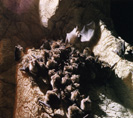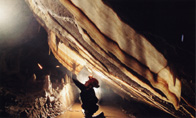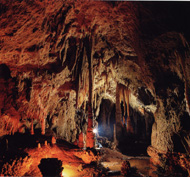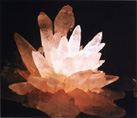Bats in Dracula's Country
This entire evolution lasted for a few milion years.The bats are older than us on Earth
|
|
| Those who happen to see in the wilderness a wild boar, a proud stag, to say nothing about the excitement of a meeting with a genuine Carpathian bear, in their natural environment, will definitely have plenty of stories to tell their whole life. But the scene is permanently animated by thousands of lively, swarming, coloured, singing beings, from ants to butterflies, lizards and chaffinches, from early morning till late at night. And when all these actors withdraw under the eiderdown of the stars, it is only at that time that the air is filled with strange beings, fluttering their wings in a kind of broken, zig-zag flight. These are the bats, those beings which are both remarkable and wronged. We meet them everywhere in Romania from Dobrogea to the Alpine regions, in the old houses attics, in the tree hollows, in the belfries. Several years ago, a bats colony caused a genuine hysteria among the guests of "Astoria" Hotel, downtown Bucharest. Moreover, recently, we could see over a TV newscast the bats which had invaded the huge building of the Parliament Palace. But the places where the bats are obviously particularly happy are the karstic regions, there where the water has dug in the limy mountains a multitude of hollows and caves. |
|
|
|
In their aspiration to fly towards the sky, their fingers have lengthened, a membrane has tied them forming a palette like a parachute and their small body has become a high power engine. This entire evolution lasted for a few million years. The bats are older than us on earth. But since the seats at the table were already occupied by some other older species when they arrived, the bats contented themselves with insects, and to be more specific, with night insects. In this way, they settled the challenge launched by the day consumers, but at the same time a new problem emerged: the orientation in the dark. That is why, the bats implemented an amazing patent: the radar. When they fly in the dark, the bats feel the objects with an infrasound spot whose reflection turns back. The signal is analysed in thousands of seconds and relying on it, the right decision is made: they further fly, they avoid the obstacle or they slip by narrow passes which are only a little larger than the dimension of their wings. When the signal: "Attention, a beetle" appears on the radar - maybe owing to the life throbbing in the insect or only to the solidity of the keratin in the elytrum - the bat opens its wings like a fishermen his sacknet - and catches the victim on the fly. We consider that the legend in keeping with which the bats rush into the women's hair could originate in some very rare cases, when a rich, vigorous hair, like the one we can see in the shampooing ads, might send to the radar of a young bat a signal similar to a swarm of insects. |
The flight of an animal which is not a bird, requires a high amount of energy. Every night they eat a quantify of insects equal to the weight of their own body. Without the bats, the predatory and prolific people of insects would register a demographic growth with inestimable ecological consequences. In the countries where the bats'number diminished, the farmers registered serious damages. That is why, in 1992, the European Community countries signed in London the International Treaty on bats'protection, the more so as there are migratory species which do not recognize the human borders. Romania acceded to this treaty in 2000. |
MONSTERS BORN OUT OF REASON'S SLEEP | |
Bats have inherited their bad reputation as early as the Middle Ages. Their nocturnal, mysterious existence, sometimes their Machiavellian aspect, their family relationship with the Chiroptera living in the tropical regions, which use to enrich their diet by sucking the blood of some animals, ranked the bats in the doubtful society of witches, owls and night spirits. But the most widely spread image for the public is obviously that of the vampire bat, Dracula'servant.
|
|
| Last update: 2002, November 7 | |||||||||
| Go to: |  Home Page |  Romania Home |  Tourism Home |  Back |  Romanian Language |  Contact Info | |||
 12000 caves have been inventoried in Romania. It is true that most of them are rather small as they cover only a few dozens meters, but there are also many caves which are longer than 5 km. And there are also a few others that are more than 10 km. long. To visit such a cave you need a few days, but such a trip, to the Wind or Humpleu caves, for instance, is as interesting as an expedition to the Fagaras Mountains. We may as well travel to other similar places all over the world where new records in terms of depth or length are being scored with every passing year, therefore demonstrating that underground there is a different geography with unknown boundaries. In Romania, there are only 5000 km. of karstic (cave bearing) rocks, while a figure ranging between 10 and 20 million sq. km. of karstic rocks, as big as a large continent, is estimated to be found throughout the world. This is a continent of mystery and explorers, of unsuspected subjects: new crystals and minerals, stone formations which exceed the power of imagination, unknown animals, paleontological and archeological vestiges. And beyond all this, we find the human curiosity and warmth, hopes, risks, fatigue, triumph, solidarity and tragedies. To put it in a nutshell, the true life. Could we find anywhere else a richer storage of topics for a story?
12000 caves have been inventoried in Romania. It is true that most of them are rather small as they cover only a few dozens meters, but there are also many caves which are longer than 5 km. And there are also a few others that are more than 10 km. long. To visit such a cave you need a few days, but such a trip, to the Wind or Humpleu caves, for instance, is as interesting as an expedition to the Fagaras Mountains. We may as well travel to other similar places all over the world where new records in terms of depth or length are being scored with every passing year, therefore demonstrating that underground there is a different geography with unknown boundaries. In Romania, there are only 5000 km. of karstic (cave bearing) rocks, while a figure ranging between 10 and 20 million sq. km. of karstic rocks, as big as a large continent, is estimated to be found throughout the world. This is a continent of mystery and explorers, of unsuspected subjects: new crystals and minerals, stone formations which exceed the power of imagination, unknown animals, paleontological and archeological vestiges. And beyond all this, we find the human curiosity and warmth, hopes, risks, fatigue, triumph, solidarity and tragedies. To put it in a nutshell, the true life. Could we find anywhere else a richer storage of topics for a story?

 This is the continent of mystery and of explorers, of unsuspected subjects: new crystals and minerals, stone formations which exceed by far the power of imagination, unknown animals, paleonthological and archeological relics.
This is the continent of mystery and of explorers, of unsuspected subjects: new crystals and minerals, stone formations which exceed by far the power of imagination, unknown animals, paleonthological and archeological relics.


